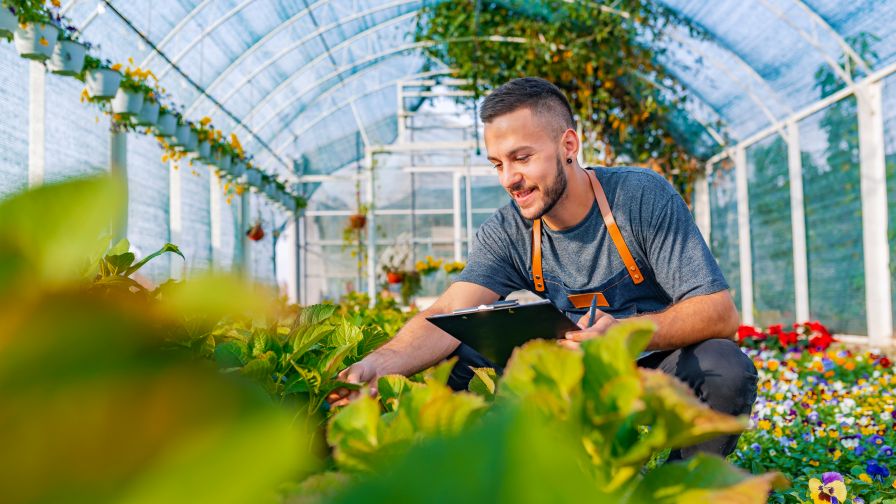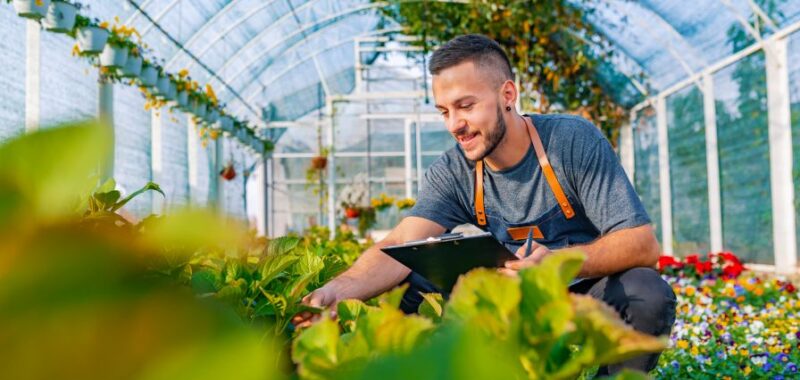
A male florist managing his plants in a greenhouse garden center | Dragana Stock Photography, Getty Images
Professional and aspiring greenhouse growers know their investment in starting and maintaining operations is vast. Expenses appear regularly, varying in frequency and value. Uncover the most lucrative purchases from a cost-benefit analysis (CBA) perspective and learn how to maximize returns on investment (ROI) for long-term sustainability.
The Greenhouse Structure
The structure is the most worthy item to spend the most money on. It is the foundation for healthy crop yields and profit consistency. A well-insulated greenhouse allows people to grow whatever they want year-round with no stopgaps. Additionally, greenhouses outfitted with next-generation environmental control technologies optimize output, leading to high-quality produce all the time.
| Initial Cost | $2,500 to $25,000, depending on size and materials. |
| Maintenance and Operational Costs | Varies based on the number of tech and staff. |
| Payback Period | Several years, depending on yields. |
| ROI | High due to long-term value and rising prices of produce. |
Climate Control Systems
Temperature regulation and humidity control are the main pillars of healthy plant growth. It permits unrestricted growing seasons and lowers disease risk due to external climate variances.
Smart climate control systems are best for greenhouses. They are proven to have the best returns because of automation and reduced energy consumption. Renewable systems show returns in less than a decade, with 22% revenue boosts alongside operational cost reductions.
| Initial Cost | Depends on the generator type. |
| Energy Costs | Potentially 42% less than initial power system costs, depending on the use of renewables and energy reductions. |
| Payback Period | Two to eight years, depending on the generator type. |
| ROI | High due to energy efficiency optimizations and reduced crop losses due to weather volatility. |
Irrigation Systems
An optimized irrigation system is critical for reducing water consumption and irrigation costs. Drip and sprinkler systems are proven to be some of the most efficient setups for farm infrastructure, though they vary in carbon emissions costs because some use more energy than others. Automation can reduce labor costs from manual watering, and sensor-based technology can detect leaks and other issues to prevent extensive maintenance expenses.
| Initial Cost | Varies depending on the system type, such as drip or gravity irrigation. |
| Maintenance Costs | Depends on usage causing wear and tear. |
| Payback Period | 15 to 25 years, with reduced water consumption but varying energy input. |
| ROI | Medium yet higher in areas with water scarcity. |
Lighting
Grow lights are some of the most critical aspects of a greenhouse because they ensure the right conditions for optimal cycles no matter the weather or time of day. Extending the length of a day makes plants healthier and faster, and smart grow lights adjust their light based on each crop’s photosynthetic preferences. This could be one of the most straightforward implementations with the highest return because it creates more harvesting opportunities.
When energy costs between 20% to 30% of the greenhouse’s overall expenses, growers will want to find energy-efficient, automated lighting solutions to reduce overhead. LEDs are the best place to invest in lighting budgets because they are the most consistent boosters for output.
| Initial Cost | Varies based on operational size. |
| Energy Costs | LEDs are the lowest energy-producing bulb type. |
| Payback Period | Based on capital investment divided by annual costs subtracted by revenue in years, could be a year or two. |
| ROI | High, which raises for high-value crops. |
Soil Management Tools
Soil management comes in numerous forms, whether monitors, sensors, or transportation mediums. Numerous peripherals can enhance soil health and maneuverability if necessary. For example, growers may need secure bulk bags and locations in the unit to store fertilizer. These preserve and distribute fertilizer easier than other invasive methods while reducing waste and expenses from replacing expired products.
Advanced technologies stimulate soil by injecting supplementary nutrients for optimal productivity, which is particularly helpful for hydroponic growing stations.
| Initial Cost | Low to none if composting for fertilizer and committing to one-time sensor purchases. |
| Maintenance Costs | Varies if repurchasing fertilizer. |
| Payback Period | Varies but is shorter with better crop health, no erosion, and optimized nutrients. |
| ROI | High because it facilitates the shortest and best growth cycles, increasing production. |
Pest and Disease Management
Chaotic temperature variances for open-air crops spread invasive species, invite pests, and breed disease. Greenhouses are a shield against these yield destroyers naturally, but other management peripherals are available.
Indoor environments can still encourage sickness and pests. The best tools for this are sensors and artificial intelligence technologies, which can constantly analyze plant appearance and predict growth based on the healthiest outcomes.
| Initial Cost | Varies based on tech. |
| Maintenance Costs | 1% to 2.5% of gross sales. |
| Payback Period | A year or two with eliminating pesticide expenses and blights, which can cost a quarter of total losses. |
| ROI | High due to reduced losses. |
The True CBA of Greenhouse Management
Price variances abound for tenured greenhouse growers and fresh agriculturists. Every asset has varying payback periods but certain returns if farmers have patience. The numbers shift based on individual greenhouse setups, such as technological incorporations, staffing needs, or use of renewable energy generators. Ultimately, intelligent, curated equipment installations improve oversight over crops, increasing yields and revenue for all greenhouse operators.

